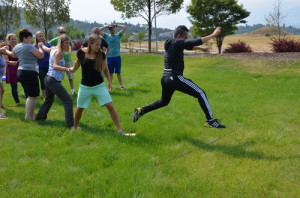
The number one focus of the OWL Methodology is community building, and it is done 100% in the target language. Through play, humor, compassion, and warm demanding, there is a sense of community in OWL classrooms that is rarely seen in educational institutions today. Together, students and teachers strive to build healthy, diverse and positive relationships and environments so that the language acquisition process can be safe and empowering.
Community building starts on day one, and is circled back to in every classroom interaction. Our students are active members in creating the classroom culture, and it starts with small interactions that grow our kids into global citizens and lifelong learners.
 High Fives! The high five is a rapid way of communicating to a person that they are important and deserve personal attention from you. When students feel that they are important in the classroom they are willing to give more to the content and to one another.
High Fives! The high five is a rapid way of communicating to a person that they are important and deserve personal attention from you. When students feel that they are important in the classroom they are willing to give more to the content and to one another.
High Five your partner and say thank you.
Cross the circle and high five 3 people you’re happy to see today.
Super secret high fives/ handshakes with a partner in class
Students sharing compliments. A compliment wields great possibility. It shows respect, admiration, approval, gratitude, trust, appreciation, and hope. When students compliment one another, the classroom becomes less about the individual student’s relationship with the teacher, and more about the recognition of every learner in the classroom.
-
- Tell a partner something you have learned from them in class.
- Write a note of admiration to someone in class.
- As you pass out paper, tell the person next to you something you recognize in them.
- Draw a picture for a friend that represents them, explain the picture to them.
Making eye contact! Eye contact has been shown to trigger brain activity related to social cognition, meaning it gets us thinking about ourselves and others.
-
- Stand face to face with a partner, count to three and see if you can both say the same word.
- Mirror- Students stand face to face. While making eye contact, students work together to perform the same moves as if they are a mirror image of one another.
- Zip – zap- zop- a whole group game students make eye contact with one another to pass the zip, zap, or zop around the class. Students know when to move based on the eye contact they have made with another classmate.
Team Cheers Team cheers bring the entire class together. They bring joy, energy, and motivation to your classroom.
-
- Wrap up each class with a one word cheer- this can wrap up content, and remind each student that they are a part of a greater whole.
- Reset your class with a chant- Having a call and response that everyone buys into brings a fun and silly way to get kids to come back to the circle for another activity.
 Team challenges Team challenges bring a synergy and a greater whole appreciation for the classroom. They help the class learn about each other — how each person thinks, works, solves problems, and has fun.
Team challenges Team challenges bring a synergy and a greater whole appreciation for the classroom. They help the class learn about each other — how each person thinks, works, solves problems, and has fun.
-
- Create a machine in the classroom- working together, each person’s body becomes a part of the machine. Each member makes an action and a noise to create a bigger whole.
- Use what you have- using only the supplies that the students have on them, create a pathway across the classroom that gets an object from point A to point B.
You can never spend too much time building community in your classroom. A strong community is the solid foundation for bringing down the affective filter and true language acquisition. Try one of these ideas in class; it’s a guaranteed way to get your students up and growing together.
Share with us! How do you build community in the classroom?
